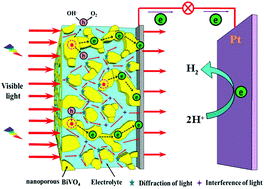Abstract: We demonstrate a facile method for the rational fabrication of pore-size controlled nanoporous BiVO4 photoanodes, and confirmed that the optimum pore-size distributions could effectively absorb visible light through light diffraction and confinement functions. Furthermore, in situ X-ray photoelectron spectroscopy (XPS) reveals more efficient photoexcited electron–hole separation than conventional particle films, induced by light confinement and rapid charge transfer in the inter-crossed worm-like structures. KeyWords Plus: SOLAR WATER OXIDATION; HYDROGEN-PRODUCTION; METAL-OXIDE; EFFICIENT; PHOTOANODES; CATALYST; EVOLUTION; CELLS; MO Published in NANOSCALE, 7 (48):20374-20379; 10.1039/c5nr06584d 2015 
|

